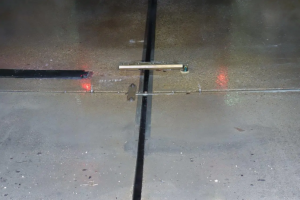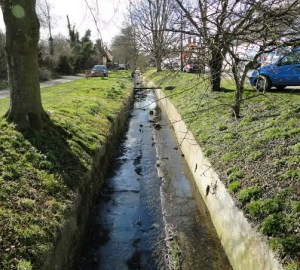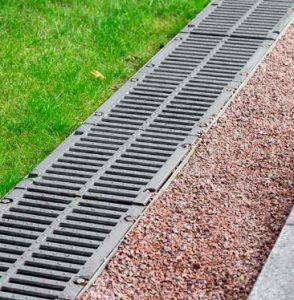Stormwater drainage is a really big deal for Tampa homeowners and businesses. Stormwater needs to have one or more outlets for drainage when storms occur, or else the water will pool, flood, and cause a variety of issues that nobody wants to deal with.
Stormwater Drainage Systems
Thankfully, there are a wide variety of ways to deal with stormwater in Tampa, with some being more effective than others. In case you’re about to implement a stormwater solution on your property or you’re looking for a better alternative to what you currently have, here are 5 types of stormwater drainage systems:
1. SLOT DRAINS
 Slot drains are a recent innovation in drainage technology. They utilize long, thin drain slots that often run the entire length of a room or area. They are great for outdoor areas that don’t require excessive drainage, however they tend to flood easily when exposed to heavy rainfall.
Slot drains are a recent innovation in drainage technology. They utilize long, thin drain slots that often run the entire length of a room or area. They are great for outdoor areas that don’t require excessive drainage, however they tend to flood easily when exposed to heavy rainfall.
This issue makes slot drains one of the least effective stormwater drainage systems. Even with multiple slot drains installed, outdoor areas are very hard to manage with this type of drain, because water quickly overflows them.
They can work effectively in light rainstorms and situations where the rate of precipitation isn’t very high. They can also be driven and walked on without issue, and are rather easy to clean when compared to other types of drains.
2. OPEN STORM DRAINS
 Open storm drains are drains that usually run parallel to a nearby road or parallel to the edge of a property. They feature long, uncovered channels to carry free-flowing stormwater. These channels often direct water into a local sewer system where it can be treated and managed. Open storm drains can be expensive to set up but are usually cheap to maintain once they’ve been installed.
Open storm drains are drains that usually run parallel to a nearby road or parallel to the edge of a property. They feature long, uncovered channels to carry free-flowing stormwater. These channels often direct water into a local sewer system where it can be treated and managed. Open storm drains can be expensive to set up but are usually cheap to maintain once they’ve been installed.
They are a great stormwater drainage setup for those who aren’t too incredibly concerned about looks, and want to collect surface water with ease. Lots and paved areas can be sloped towards open storm drains. They are unsafe, though, and require fencing to keep animals and people from falling in. They can also smell and may even decrease your property value.
3. CLOSED STORM DRAIN
 Most of the stormwater management systems you see now are stormwater grates that lead to a local, underground sewer system. Closed storm drain grates can be found in the low areas of parking lots, the trenches near sidewalks, and other areas where water intentionally or unintentionally tends to collect. Though safer and less unsightly than open storm drains, they are difficult to clean.
Most of the stormwater management systems you see now are stormwater grates that lead to a local, underground sewer system. Closed storm drain grates can be found in the low areas of parking lots, the trenches near sidewalks, and other areas where water intentionally or unintentionally tends to collect. Though safer and less unsightly than open storm drains, they are difficult to clean.
Tampa Bay has a serious problem
4. FRENCH DRAIN
 If you want to prevent water from pooling around the foundation of your home or building, french drains are the way to accomplish it. These types of stormwater drains typically utilize small grates located near the foundation of a building. The grates funnel the water into long pipes that carry it away from the edge of the building and into the street, or even into a water retention basin.
If you want to prevent water from pooling around the foundation of your home or building, french drains are the way to accomplish it. These types of stormwater drains typically utilize small grates located near the foundation of a building. The grates funnel the water into long pipes that carry it away from the edge of the building and into the street, or even into a water retention basin.
The best part about French drains is that the long pipes they use are almost always covered up with aesthetically pleasing pebbles or grass. They also make use of intricate, beautiful grates as well. French drains are great for draining water that pools near the foundation of a building, but are not as effective when it comes to draining surface water over a broader area.
For All Your Storm Sewer Needs, Call Cass Plumbing
 When you need storm sewer service talk to the Tampa storm sewer experts at Cass Plumbing. We install
When you need storm sewer service talk to the Tampa storm sewer experts at Cass Plumbing. We install and repair storm sewer systems all throughout the Greater Tampa Bay region. Our friendly team is waiting for your call, and we’d love to help you do your part to manage storm water runoff. Contact us today at (813) 265-9200.
and repair storm sewer systems all throughout the Greater Tampa Bay region. Our friendly team is waiting for your call, and we’d love to help you do your part to manage storm water runoff. Contact us today at (813) 265-9200.






